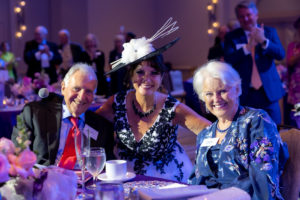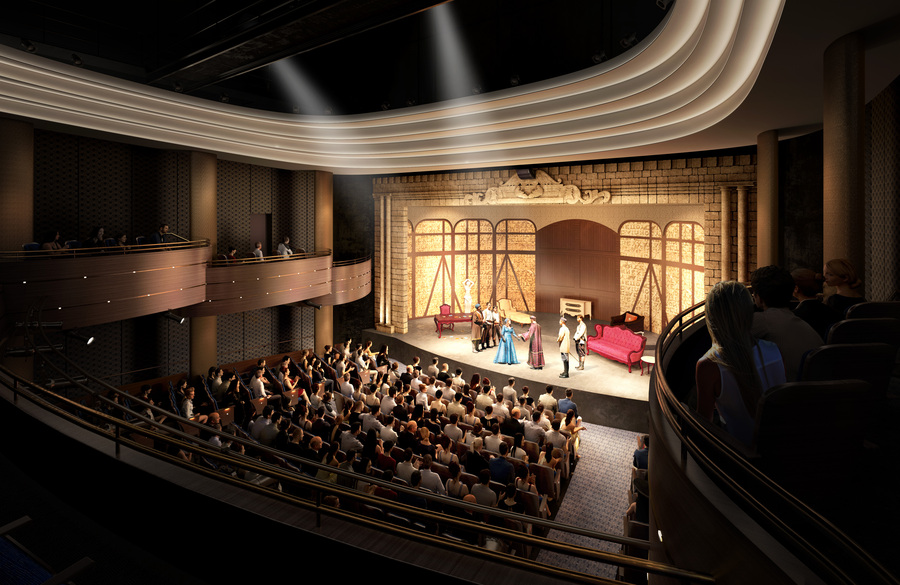As a theatre artist, I know to trust my intuition.
After years of the hustle and grind of working in commercial theatre, I was yearning for a change. When I happened to stop over in Naples on a trip along coastal Florida in 2003, my intuition told me that this was the place I needed to be to make my dreams a reality. And so I left New York without looking back, and that is where the story of Gulfshore Playhouse began.
Getting from that first visit to here, on the cusp of breaking ground on a new $60 million state-of-the-art venue, has certainly been a journey of highs and lows. To paraphrase our board chairman’s speech from a recent capital campaign event, Gulfshore Playhouse is “an overnight success that was 17 years in the making.”

During my time in New York City, I saw dozens, if not hundreds, of productions that ran the gamut of quality. Sitting in the dark and watching, I found that the highest-quality productions had the biggest impact upon me. I wanted to create theatre of that caliber, and I wanted to share it with others. When I created Gulfshore Playhouse, that passion shaped my vision for what life-changing theatre could be. My first condo in Naples overlooked an empty plot of land where I’d close my eyes and visualize a Tony-winning theatre growing out of the ground. As fate would have it, that same plot of land is the future home of Gulfshore Playhouse.
I employed the Merlin Principle: working backward from a vision to ensure that we were on the right path. The idea is to imagine what you want in explicit detail and then work backward, strategically identifying goals, benchmarks, and milestones that will get you from vision to reality. Do everything to make it happen: Take every meeting, shake every hand, never lose sight of your vision, and never sacrifice your principles. Share your vision with others and get them excited about playing a role. Your company culture and that vision will attract the right people to your team.
Patience is key. In the early days, Gulfshore Playhouse had a full-time staff of one and very few resources. It took several lean years of creating small revues and fundraisers in found spaces before we mounted our first full production and began adding employees.
With the help of other visionaries, and a growing community of supporters, we were able to meet our financial goals and raise our budget each year. This trick comes from the school of life: Act as if what you want to be true is true, and never take your eye off the end goal. More conventional thinking tells you to add one to two percent to whatever you raised or made this year to project next year’s goals. My method instead was to visualize how I wanted the company to grow in the coming year, and enumerate the people I would need to run the programs I wanted to create, and then focus on fundraising so we could raise the budget to meet those goals. As a result of this unconventional method, Gulfshore Playhouse has often experienced more than 20 percent annual budget increases over the better part of the past decade, all while maintaining a net surplus.
Without persistence, Gulfshore Playhouse never would have gotten off the ground. Nor would it have weathered an economic recession, a Category 5 hurricane, and a global pandemic. When the initial shutdown occurred in March 2020, we felt the same fear that every other performing arts organization on earth likely felt. When, or even if, this pandemic ended, would there still be a theatre to return to? That outcome was untenable. Like other theatres, we cancelled the remainder of our season and were forced to let the majority of our staff go. Our least favorite yet most used words became “pivot,” “adapt,” “unprecedented,” and “virtual.”
And so we went to work. The few staff members we retained, lovingly referred to as our “G8,” created a virtual ritual: Every morning at 10 a.m., we met virtually to discuss everything as a group, from fundraising strategies to education, to how and when we could get a show onstage again.

Our crack development team, supported by the whole staff, turned their focus to turning unused tickets into donations and patron credits. We experienced tremendous support from our patrons. Nearly 60 percent contributed their tickets back, an outcome I attribute to the fact that we are and always have been focused on the patron experience. That includes a comprehensive “welcoming strategy” from the moment they walk in the lobby doors, and a comprehensive “thanking strategy,” including thank-you notes on seats, handwritten notes and emails sent immediately after receiving a donation and in advance of the tax letter, and, in pre-COVID times, a personal greeting from yours truly as often as possible.
This support gave us the stability we needed to ask ourselves what we could do to serve our community. During the summer, we created a virtual “arts talk show” called Artful Distancing, a free one-hour behind-the-scenes program that featured everything from director/actor discussions to “a day in the life of a casting director” to a Shakespeare scholar explaining the Bard’s apostrophes. And while we initially took our student training virtual, featuring our regular classes as well as master classes by people such as Laura Osnes and Adam Cates, we worked diligently to get our students live onstage as quickly as we could. Amid countless plans that were about as sturdy as a house of cards, considering the unpredictability of the situation, we persisted.
One of the unexpected benefits of suddenly having a very open calendar was that we were able to focus on our new building. Our “design development” stage ended about the same time as the pandemic began. What would have entailed in-person meetings in New York turned into three-hour virtual meetings a week, where we dug thoroughly into every detail of the building.
We finished construction documents in the fall of 2020 and turned our focus to raising enough money to break ground—as well as figuring out how to convince Actors’ Equity Association to let us put a show onstage. We had our full staff back by the first week of October in hopes that we could start producing at the beginning of the professional season. Our former associate artistic director penned a one-person show in which he would also star, and we hoped we’d be able to put it before a live audience in the fall. Unfortunately, high COVID case rates in our area led Equity to say no. Instead we asked the Screen Actors Guild for permission to film it, and we proudly distributed a professional filming of Higher, by Jeffrey Binder, in January.
That experience didn’t dissuade us from trying again. We enlisted two of our favorite actors, who also happen to be a cohabiting couple, to star in A.R. Gurney’s Love Letters. Our tireless managing director, Joel Markus, was in almost daily negotiations with Equity by that point. How did we convince them to allow us to be able to produce a show inside, at a time when they were saying no to just about everything? I believe it’s because, no matter what they asked us to do, we said yes, until they couldn’t say no. Thanks to an incredible partnership with our local hospital, we were able to have our cast and crew tested for COVID three times a week. And fortunately our venue’s air-conditioning unit was quite new and met Equity’s standards. Our detailed safety plan included mandatory masks and reduced capacity helped mitigate risk as much as possible.
I’m happy to report it was a complete success. We administered 475 COVID tests, produced 47 nights of live events, and kept over 7,000 people safe. It was clear that much of our usual audience wasn’t quite ready to return, but those who did were effusive about the performance. We had concocted a recipe for success, and with the COVID-19 vaccine starting to roll out, we figured, why not try again? We were thrilled when we received a second approval for Maytag Virgin, by Audrey Cefaly, which, even at reduced capacity, exceeded projections by 100 percent.
While all of this was happening, our capital campaign was picking up steam once more. We successfully raised $14 million in pledges over the course of three months between December 2020 and March 2021.
There were, and continue to be, many moving pieces with regard to our building project. I’ve learned more about parking garages and zoning law than I ever thought I’d need to know when I started a professional theatre company. But, if any of you happen to have a legal background, I can promise it won’t go to waste if you ever start to build a regional theatre.
On April 21, we hosted an outdoor event on the very land where I once visualized a theatre. Though the intention was to celebrate the progress of our capital campaign and rally the community around raising the remaining funds we needed to reach groundbreaking, it felt like a celebration of so much more than that. Not only had we made it through the most challenging year in the organization’s history, we were moving forward on our capital campaign, and we’d safely produced live theatre along the way. Little did we suspect that our initial transformational donors, Patty and Jay Baker, would step up with another $10 million challenge, giving us about two and a half months (through July 4) to make the match. We’re in that process now, and we’ve exceeded what we need to officially break ground in September.
It hardly bears repeating how difficult the past 14 months were for our industry, and how long it will be until we recover fully. But I feel blessed in a variety of ways: We retained some amazing staff, and welcomed some incredible new employees into our family. We learned how to communicate in a more caring, tolerant, and understanding fashion with each other. We were able to take a breath, take some time, and evaluate why we made theatre. I personally became more committed to the live experience than ever before. We learned that resilience, optimism, and hope were valuable assets.
And we learned, above all, to stay ready, so that when the opportunity arose, we were poised and ready to fly.
Kristen Coury (she/her) is CEO, founder, and producing artistic director of Gulfshore Playhouse.


